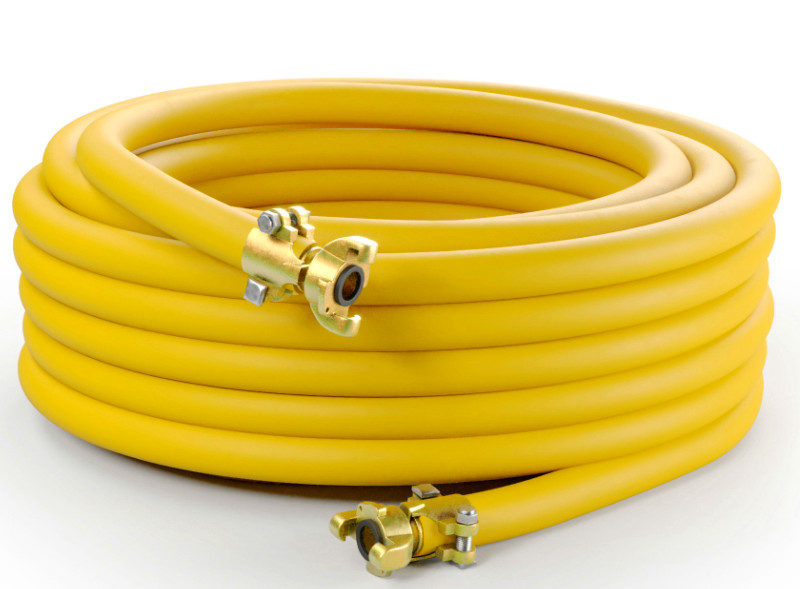When you’re working with an air compressor, having the right air hose can make all the difference. Your tools depend on steady, reliable airflow to perform at their best.
But not every air hose is built the same. Choosing the wrong one can lead to leaks, pressure drops, or even costly damage to your equipment. You’ll discover exactly what to look for in an air hose for your air compressor.
By the end, you’ll know how to pick a hose that keeps your projects running smoothly and saves you time and frustration. Keep reading—you’re about to make your work easier and more efficient.

Credit: www.somaxflex.com
Choosing The Right Air Hose
Choosing the right air hose for your air compressor is important. It affects how well your tools work and how safe you are. The right hose makes your job easier and lasts longer.
Many factors matter when picking an air hose. You must know the types, materials, length, and diameter. Each part plays a role in performance and durability.
Types Of Air Hoses
Several air hose types exist for different tasks. Rubber hoses are strong and flexible. They handle high pressure well.
PVC hoses are light and cheaper. They work best for light-duty jobs and low pressure. Hybrid hoses mix materials. They offer good strength and flexibility.
Spiral hoses coil up easily. They save space and avoid tangling. Choosing the right type depends on your work needs.
Material Comparison
Materials affect hose weight, flexibility, and strength. Rubber is durable and resists wear. It stays flexible in cold weather.
PVC is lighter but less durable. It can crack in cold temperatures. Hybrid hoses combine benefits of rubber and PVC. They provide good flexibility and toughness.
Consider the environment and how often you use the hose. This helps pick the best material for your tasks.
Length And Diameter Considerations
Length matters for reach and pressure. A longer hose reaches far but may reduce air pressure. A shorter hose keeps strong pressure but limits movement.
Diameter affects air flow. Larger diameter hoses carry more air. This suits big tools needing high airflow. Smaller hoses work for light tools and save space.
Choose length and diameter based on your air tool needs and workspace size.
Air Hose Features Impacting Performance
An air hose is essential for the air compressor to work well. Its features affect how well air flows and how easy it is to use. Choosing the right hose can save time and effort. Knowing what matters helps pick the best hose for your needs.
Flexibility And Weight
Flexible hoses bend easily and reach tight spots. Heavy hoses tire your arm faster. Lightweight hoses make work smoother and less tiring. Check the hose material for good bend and light weight.
Pressure Ratings
Pressure rating shows the highest air pressure a hose can handle. Using a hose with low rating may cause leaks or bursts. Always pick a hose with pressure rating above your compressor’s max pressure.
Temperature Resistance
Some jobs need hoses that handle hot or cold air. Temperature resistance means the hose works well in harsh weather. Choose hoses that keep air flow steady in different temperatures.
Maintaining Air Hose Efficiency
Maintaining air hose efficiency is key to getting the best from your air compressor. A well-kept air hose lasts longer and works better. Small steps in care prevent big problems later. Keep your hose clean, safe, and free of damage for top performance.
Proper Storage Tips
Store the air hose in a dry, cool place away from sunlight. Avoid sharp bends or kinks that can weaken the hose. Use hose reels or hooks to keep the hose off the ground. Proper storage stops cracks and leaks from forming.
Regular Inspection And Repair
Check the hose often for signs of wear, cracks, or leaks. Look at the fittings and connections too. Fix small holes or replace worn parts quickly. Regular checks keep your air hose safe and working well.
Avoiding Common Damage Causes
Keep the hose away from sharp objects and rough surfaces. Do not pull or drag the hose forcefully. Avoid exposing the hose to extreme heat or chemicals. These actions can cause damage and reduce hose life.
Connecting And Using Air Hoses
Connecting and using air hoses correctly is key to getting the best from your air compressor. Proper connections ensure steady airflow and strong performance. Careful use helps avoid damage and keeps you safe during work.
Fittings And Couplers
Use the right fittings and couplers for your air hose. They join the hose to the compressor and tools. Choose ones that fit tightly and match the hose size. Quick-connect couplers make changing tools fast and easy. Check for wear and replace old or damaged parts to keep connections secure.
Minimizing Air Leaks
Air leaks waste power and slow your job. Check all connections for leaks before use. Tighten fittings by hand, then use a wrench for a snug fit. Use thread seal tape on threaded connections to stop leaks. Avoid twisting or kinking the hose as it can cause leaks over time.
Safe Handling Practices
Handle air hoses with care to avoid injuries. Do not pull or drag hoses over sharp edges. Coil hoses properly after use to prevent tangles and cracks. Keep hoses away from heat and oil to extend their life. Wear safety glasses to protect your eyes from unexpected hose bursts.
Upgrading For Better Performance
Upgrading your air hose can greatly improve your air compressor’s performance. A better hose means stronger airflow, less energy waste, and safer use. Choosing the right hose helps you work faster and with more precision. It also reduces wear and tear on your tools. Investing in a quality hose is a smart way to boost efficiency and durability.
High-quality Hose Brands
Top brands offer durable hoses that resist kinks and cracks. These hoses maintain steady air pressure for consistent tool performance. Many brands use strong materials like reinforced rubber or PVC. Trusted brands also provide hoses with longer warranties. This ensures your investment lasts through tough jobs and frequent use.
Innovative Hose Technologies
New hose designs improve flexibility and strength. Some hoses have anti-static layers to prevent sparks. Others feature lightweight materials for easier handling. Innovative hoses reduce air leaks and improve energy use. These advancements help you work longer without fatigue or interruptions.
Customizing For Specific Tasks
Choosing the right hose length and diameter fits your needs. Shorter hoses reduce pressure loss for close work. Longer hoses offer freedom to move around large areas. Some hoses come with special fittings for specific tools. Customizing hoses ensures better control and efficiency on every job.

Credit: twen.rs-online.com

Credit: www.amazon.com
Frequently Asked Questions
What Is The Best Air Hose For Air Compressors?
The best air hose is durable, flexible, and rated for your compressor’s PSI. Materials like polyurethane or rubber offer good strength and flexibility. Choose the right length and diameter for your tools to maintain optimal air flow and performance.
How Do I Choose The Right Air Hose Size?
Select an air hose with the correct diameter to match your compressor and tools. Larger diameters reduce pressure drop, improving efficiency. Typical sizes are 1/4″, 3/8″, or 1/2″ depending on your air tool requirements and compressor capacity.
Can I Use Any Air Hose With My Compressor?
Not all hoses suit every compressor. Use hoses rated for your compressor’s maximum PSI and flow rate. Check compatibility with tool fittings and ensure the hose material withstands your working environment to avoid damage and leaks.
How Long Should An Air Hose Be For Compressors?
Air hose length affects pressure loss. Keep hoses as short as possible while allowing comfortable tool movement. Typical lengths range from 25 to 50 feet. Longer hoses may require larger diameters to maintain air pressure.
Conclusion
Choosing the right air hose keeps your air compressor working well. A good hose lasts longer and stays safe under pressure. Check the hose size and material to match your needs. Keep the hose clean and store it properly to avoid damage.
Using the right air hose saves time and effort during tasks. Always inspect the hose for cracks or leaks before use. A strong, flexible hose makes your work easier and faster. Small steps lead to better results with your air compressor.

